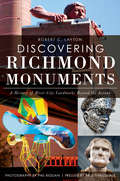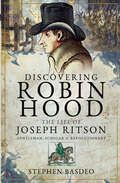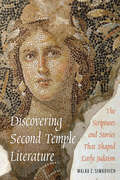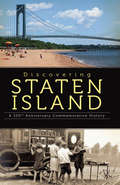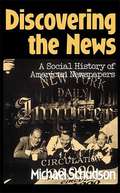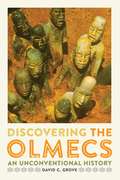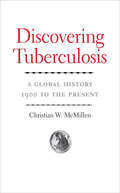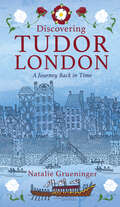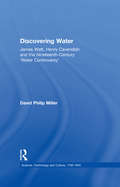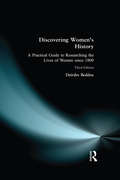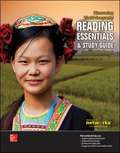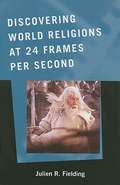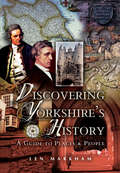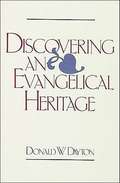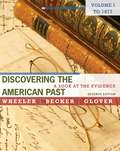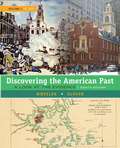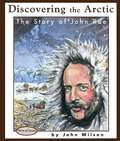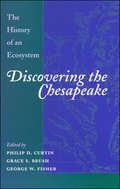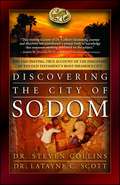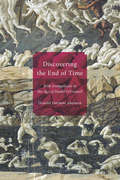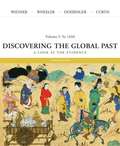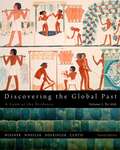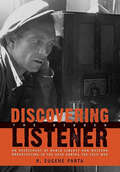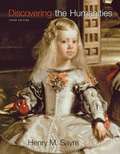- Table View
- List View
Discovering Richmond Monuments: A History of River City Landmarks Beyond the Avenue (Landmarks)
by Robert C. LaytonWith over 150 monuments, Richmond ranks among the nation's best cities in devotion to its past, its leaders and its famous citizens. But the storied history of Virginia's capital extends far beyond its most famous figures. Whether memorializing the captivating stories of famous Richmonders Nina Abady and Sam Woods, celebrating the life of Bill "Bojangles" Robinson or honoring the achievements of prominent medical leaders, public art in Richmond is a testament to the perseverance and ingenuity of the city and its people. Journey into times past with author Robert Layton as he uncovers the enthralling history of Richmond through its often-overlooked monuments.
Discovering Robin Hood: The Life of Joseph Ritson—Gentleman, Scholar & Revolutionary
by Stephen BasdeoThe name of Joseph Ritson, born in Stockton-on-Tees in 1752, will be familiar to very few people. The name of Robin Hood is known the world over. Yet it was Ritson whose research in the late eighteenth century ensured the survival of the Robin Hood legend. He traveled all over the country looking for ancient manuscripts which told of the life and deeds of England’s most famous outlaw. Without his efforts, the legend of Robin Hood might have gone the way of other medieval outlaws such as Adam Bell — famous in their day but not so much now. Yet this is not only a story about the formation of the Robin Hood legend. Ritson’s story is one of rags to riches. Born in humble circumstances, his aptitude for learning meant that he rose through society’s ranks and became a successful lawyer, local official, and a gentleman. However, underneath the genteel and bourgeois façade of Joseph Ritson, Esq. was a revolutionary: having traveled to Paris at the height of the French Revolution, he was captivated by the revolutionaries’ ideology of liberté, egalité, fraternité. He returned to England as a true democrat who sought the abolition of the British monarchy and the ‘rotten’ parliamentary system and wished for French Revolution and its reign of terror to spread over to England. This the history of the life and times of Joseph Ritson: gentleman, scholar, and revolutionary.
Discovering Second Temple Literature: The Scriptures and Stories That Shaped Early Judaism
by Malka Z. SimkovichExploring the world of the Second Temple period (539 BCE–70 CE), in particular the vastly diverse stories, commentaries, and other documents written by Jews during the last three centuries of this period, Malka Z. Simkovich takes us to Jerusalem, Alexandria, and Antioch, to the Jewish sectarians and the Roman-Jewish historian Josephus, to the Cairo genizah, and to the ancient caves that kept the secrets of the Dead Sea Scrolls. As she recounts Jewish history during this vibrant, formative era, Simkovich analyzes some of the period’s most important works for both familiar and possible meanings. This volume interweaves past and present in four parts. Part 1 tells modern stories of discovery of Second Temple literature. Part 2 describes the Jewish communities that flourished both in the land of Israel and in the Diaspora. Part 3 explores the lives, worldviews, and significant writings of Second Temple authors. Part 4 examines how authors of the time introduced novel, rewritten, and expanded versions of Bible stories in hopes of imparting messages to the people. Simkovich’s popular style will engage readers in understanding the sometimes surprisingly creative ways Jews at this time chose to practice their religion and interpret its scriptures in light of a cultural setting so unlike that of their Israelite forefathers. Like many modern Jews today, they made an ancient religion meaningful in an ever-changing world.
Discovering Staten Island: A 350th Anniversary Commemorative History
by Staten Island 350 Anniversary CommitteeAs one of the five boroughs of New York City, Staten Island has a rich and colorful past, and it is full of places where people have shaped the city, state and nation. To commemorate its 350th anniversary, local community leaders and educators have gathered together this unprecedented collection. Walk in the footsteps of Benjamin Franklin, Susan B. Anthony, Langston Hughes, Jacqueline Kennedy Onassis and the Dalai Lama; visit Revolutionary War sites; relive the entrepreneurial drive and inventiveness of business and medical pioneers; and imagine the lives of Irish, Norwegian, Italian, Sri Lankan and Liberian immigrants. Its shores are awash in history, from Lenape trails to Dutch and French farms, from the Atlantic Terra Cotta Company to legendary sports figures and quaint historic districts. Their struggles, hardships, triumphs and achievements, in spectacular and everyday Staten Island locations, are brought to life.
Discovering The News: A Social History Of American Newspapers
by Michael SchudsonThis instructive and entertaining social history of American newspapers shows that the very idea of impartial, objective "news" was the social product of the democratization of political, economic, and social life in the nineteenth century. Professor Schudson analyzes the shifts in reportorial style over the years and explains why the belief among journalists and readers alike that newspapers must be objective still lives on.
Discovering The Olmecs: An Unconventional History
by David GroveThe Olmecs are renowned for their massive carved stone heads and other sculptures, the first stone monuments produced in Mesoamerica. Seven decades of archaeological research have given us many insights into the lifeways of the Olmecs, who inhabited parts of the modern Mexican states of Veracruz and Tabasco from around 1150 to 400 BC, and there are several good books that summarize the current interpretations of Olmec prehistory. But these formal studies don't describe the field experiences of the archaeologists who made the discoveries. What was it like to endure the Olmec region's heat, humidity, mosquitoes, and ticks to bring that ancient society to light? How did unforeseen events and luck alter carefully planned research programs and the conclusions drawn from them? And, importantly, how did local communities and individuals react to the research projects and discoveries in their territories? <p><p> In this engaging book, a leading expert on the Olmecs tells those stories from his own experiences and those of his predecessors, colleagues, and students. Beginning with the first modern explorations in the 1920s, David Grove recounts how generations of archaeologists and local residents have uncovered the Olmec past and pieced together a portrait of this ancient civilization that left no written records. The stories are full of fortuitous discoveries and frustrating disappointments, helpful collaborations and deceitful shenanigans. What emerges is an unconventional history of Olmec archaeology, a lively introduction to archaeological fieldwork, and an exceptional overview of all that we currently know about the Olmecs.
Discovering Tuberculosis
by Christian W. McmillenTuberculosis is one of the world's deadliest infectious diseases, killing nearly two million people every year--more now than at any other time in history. While the developed world has nearly forgotten about TB, it continues to wreak havoc across much of the globe. In this interdisciplinary study of global efforts to control TB, Christian McMillen examines the disease's remarkable staying power by offering a probing look at key locations, developments, ideas, and medical successes and failures since 1900. He explores TB and race in east Africa, in South Africa, and on Native American reservations in the first half of the twentieth century, investigates the unsuccessful search for a vaccine, uncovers the origins of drug-resistant tuberculosis in Kenya and elsewhere in the decades following World War II, and details the tragic story of the resurgence of TB in the era of HIV/AIDS. Discovering Tuberculosis explains why controlling TB has been, and continues to be, so difficult.
Discovering Tudor London: A Journey Back in Time
by Natalie GrueningerThis engaging and practical travel guide takes you on a journey through the best of Tudor London, to sites built and associated with this fascinating dynasty, and to the museums and galleries that house tantalising treasures from this rich period of history. Join the author as she explores evocative historical sites, including the magnificent great hall of Eltham Palace, the most substantial surviving remnant of the medieval palace where Henry VIII spent time as a child, and the lesser-known delights of St Helen’s Church, dubbed the ‘Westminster Abbey of the City’ for its impressive collection of Tudor monuments. A range of photographs, maps and visitor information, together with an informative narrative, bring the most intriguing personalities and stories of the thirty plus sites across Greater London vividly to life. This a must have companion for both those planning their own ‘Tudor pilgrimage’ and for the armchair traveller alike.
Discovering Water: James Watt, Henry Cavendish and the Nineteenth-Century 'Water Controversy' (Science, Technology and Culture, 1700-1945)
by David Philip MillerThe 'water controversy' concerns one of the central discoveries of modern science, that water is not an element but rather a compound. The allocation of priority in this discovery was contentious in the 1780s and has occupied a number of 20th century historians. The matter is tied up with the larger issues of the so-called chemical revolution of the late eighteenth century. A case can be made for James Watt or Henry Cavendish or Antoine Lavoisier as having priority in the discovery depending upon precisely what the discovery is taken to consist of, however, neither the protagonists themselves in the 1780s nor modern historians qualify as those most fervently interested in the affair. In fact, the controversy attracted most attention in early Victorian Britain some fifty to seventy years after the actual work of Watt, Cavendish and Lavoisier. The central historical question to which the book addresses itself is why the priority claims of long dead natural philosophers so preoccupied a wide range of people in the later period. The answer to the question lies in understanding the enormous symbolic importance of James Watt and Henry Cavendish in nineteenth-century science and society. More than credit for a particular discovery was at stake here. When we examine the various agenda of the participants in the Victorian phase of the water controversy we find it driven by filial loyalty and nationalism but also, most importantly, by ideological struggles about the nature of science and its relation to technological invention and innovation in British society. At a more general, theoretical, level, this study also provides important insights into conceptions of the nature of discovery as they are debated by modern historians, philosophers and sociologists of science.
Discovering Women's History: A Practical Guide to Researching the Lives of Women since 1800
by Deirdre BeddoeThe highly practical guide introduces the reader to the main areas of British women's history: education, work, family life, sexuality and politics. After an introduction to each topic detailed commentary is provided on a range of primary source material together with advice on further reading. For the new edition the author has written a brand new chapter on how to choose a dissertation subject and the pitfalls to avoid.
Discovering World Geography, Reading Essentials And Study Guide, Student Workbook
by Mcgraw-Hill Education BoehmReading Essentials and Study Guide (English and Spanish): Reinforce critical concepts from the text and help students improve their reading-for-information skills with this essential resource, written 2-3 grade levels below the Student Edition
Discovering World Religions at 24 Frames Per Second
by Julien R. FieldingTraditionally, university students have gained access to world religions by reading primary texts. Discovering World Religions at 24 Frames Per Second takes students beyond the written page, offering an exploration of the same religious traditions through the study of feature films. The many definitions of religion are examined along with its various components, including doctrine, myth, ethics, ritual, and symbol. Specific religious traditions, including Hinduism, Sikhism, Zoroastrianism, Buddhism, Confucianism, Daoism, popular religion, and Shinto are examined. Biographical sketches of directors whose films tend to focus on a particular religious tradition are also included, such as Zhang Yimou, Hayao Miyazaki, Deepa Mehta, and Akira Kurosawa. Discovering World Religions at 24 Frames Per Second is unique in the area of religion and film studies in that it isn't just a collection of essays. Instead it provides the introductory student with the necessary background information on the various religions before looking at how their ideas can be understood not through texts but through the cinematic medium. To keep the conversation fresh, most of the films used in the book were made within the last decade. Furthermore, examples range from popular, mainstream fare, such as Star Wars and the Lord of the Rings trilogy to lesser-known foreign films, such as The Wooden Man's Bride and The Great Yokai War. Several films with a "cult-like" following are also discussed, including Fight Club, Princess Mononoke, Spirited Away, and Jacob's Ladder. This book is also unique in that instead of drawing upon the Judeo-Christian tradition, it draws from Eastern traditions.
Discovering Yorkshire's History: A Guide to Places and People
by Len MarkhamOver the centuries Yorkshire, the largest and most varied country in England, has helped to shape the history of the nation. From the barrier of the Pennines in the west to the bastion of Falmborough in the east, the region has seen war, insurrection, invention, industrial expansion, political and social development and pioneering achievements in literature, art and science. In this unconventional guide to the people and the places that played parts in this extraordinary story, author Len Markham takes the reader across the country and down the years. He retells the stories of many of the well-known sites and uncovers the intriguing, sometimes secret history of places that are rarely remembered and visited. Along the way he describes the careers and achievements of an exceptional cast of characters- monarchs, bishops, generals, industrialists, inventors, artists, renegades, rogues, eccentrics, murderers and otherwise ordinary men and woman who made a mark for good or ill on the heritage of the country. Over 150 evocative sites are described and illustrated in this invaluable handbook to the intense, sometimes bizarre and always revealing history of Yorkshire.
Discovering an Evangelical Heritage
by Donald W. DaytonWhen it first appeared, Discovering an Evangelical Heritage was widely regarded as a groundbreaking historical work. The continued relevance of the issues with which this book deals justifies its reappearance twelve years after its first advent challenged countless people to rethink their Evangelical heritage. If anything, the challenge is even greater now to follow the example set by the forebears of twentieth century evangelicalism. For instance, Catherine Booth, co-founder of the Salvation Army and ardent feminist, offers a powerful testimony to the impact that Christian witness can and should have upon society. Likewise, abolitionist Theodore Weld, converted under the ministry of Charles G. Finney, showed what a response to the radical call of Christ means as he strove to right social injustice and inequity during his day. Despite the hardship and consequences of living out their faith, these and other evangelical forerunners left a heritage to be remembered and an example to be followed. Like the author himself, the reader will be challenged to rethink his or her own relationship with Evangelicalism and will have to reflect upon the broader significance of that movement in American culture.
Discovering the American Past: To 1877
by William Bruce Wheeler Lorri Glover Susan D. BeckerThis primary source reader in the popular DISCOVERING series contains a six-part pedagogical framework that guides readers through the process of historical inquiry and explanation. The text emphasizes historical study as interpretation rather than memorization of data. Each chapter is organized around the same pedagogical framework: The Problem, Background, The Method, The Evidence, Questions to Consider, and Epilogue. The Seventh Edition integrates new documents and revised coverage throughout. For example, the Reconstruction chapter, appearing in Volumes I and II, now explores Thomas Nast's political cartoons and their effect on public opinion.
Discovering the American Past: To 1877
by William Bruce Wheeler Lorri GloverThis primary source reader in the popular DISCOVERING series contains a six-part pedagogical framework that guides students through the process of historical inquiry and explanation. The text emphasizes historical study as interpretation rather than memorization of data. Each chapter is organized around the same pedagogical framework: The Problem, Background, The Method, The Evidence, Questions to Consider, and Epilogue. Volume I of the Eighth Edition integrates new documents and revised coverage throughout. For example, there are new chapters on creation stories and culture in colonial America, the transition to racial slavery in Virginia, women's rights, and Civil War nurses.
Discovering the Arctic: The Story of John Rae
by John WilsonShort-listed for the 2004 Canadian Children’s Book Centre Norma Fleck Award and commended for the 2004 Best Books for Kids and Teens Discovering the Arctic is an exciting recounting of the life of a 19th century doctor and explorer who worked for the Hudson’s Bay Company and opened up vast tracts of land in the Canadian Arctic and may have been the true discoverer of the Northwest Passage. Rae discovered the fate of the failed Franklin Expedition and evidence of cannibalism on the bones he found, but he was disgraced by a slanderous campaign against his name, which resulted in a century of subsequent obscurity. Rae was one of the first Europeans to show respect for Inuit customs and to take inspiration from their Arctic survival skills. John Wilson brings this fascinating man and his times to life in an exciting narrative full of survival stories, shipwrecks and scandals. The book is illustrated with sketches, maps and archival photos.
Discovering the Chesapeake: The History of an Ecosystem
by George W. FisherWith its rich evolutionary record of natural systems and long history of human activity, the Chesapeake Bay provides an excellent example of how a great estuary has responded to the powerful forces of human settlement and environmental change. Discovering the Chesapeake explores all of the long-term changes the Chesapeake has undergone and uncovers the inextricable connections among land, water, and humans in this unusually delicate ecosystem.Edited by a historian, a paleobiologist, and a geologist at the Johns Hopkins University and written for general readers, the book brings together experts in various disciplines to consider the truly complex and interesting environmental history of the Chesapeake and its watershed. Chapters explore a variety of topics, including the natural systems of the watershed and their origins; the effects of human interventions ranging from Indian slash-and-burn practices to changing farming techniques; the introduction of pathogens, both human and botanical; the consequences of the oyster's depletion; the response of bird and animal life to environmental factors introduced by humans; and the influence of the land and water on the people who settled along the Bay.Discovering the Chesapeake, originating in two conferences sponsored by the National Science Foundation, achieves a broad historical and scientific appreciation of the various processes that shaped the Chesapeake region."Today's Chesapeake Bay is only some ten thousand years old. What a different world it was... when the region was the home of the ground sloth, giant beaver, dire wolf, mastodon, and other megafauna. In the next few thousand years, the ice may form again and the Bay will once more be the valley of the Susquehanna, unless, of course, human-induced changes in climate create some other currently unpredictable condition."—from the Introduction
Discovering the City of Sodom: The Fascinating, True Account of the Discovery of the Old Testament's Most Infamous City
by Steven Collins Latayne ScottThe fascinating, true account of the quest for one of the Old Testament's most infamous cities.Like many modern-day Christians, Dr. Steven Collins struggled with what seemed to be a clash between his belief in the Bible and the research regarding ancient history--a crisis of faith that inspired him to put both his education and the Bible to the test by embarking on an expedition that has led to one of the most exciting finds in recent archaeology. Recounting Dr. Collins's quest for Sodom in absorbing detail, this adventure-cum-memoir reflects the tensions that define Biblical archaeology as it narrates a tale of discovery. The book follows Dr. Collins as he tracks down Biblical, archaeological, and geological clues to the destruction of Sodom and Gomorrah, narrowing down the list of possible sites as he weighs evidence and battles skeptics. Finally, he arrives at a single location that looms as the only option: a massive site called Tall el-Hammam in the Hashemite Kingdom of Jordan. Challenging the assumptions of academics around the world, Discovering the City of Sodom may well inspire a revision of the history books. Dr. Collins has become a new voice in the controversy over using the Bible as a credible source of understanding the past--and opened a new chapter in the struggle over the soul of Biblical archaeology.
Discovering the End of Time: Irish Evangelicals in the Age of Daniel O'Connell
by Donald Harman AkensonApocalyptic millennialism is embraced by the most powerful strands of evangelical Christianity. The followers of these groups believe in the physical return of Jesus to Earth in the Second Coming, the affirmation of a Rapture, a millennium of peace under the rule of Jesus and his saints, and, at last, final judgment and deep eternity. In Discovering the End of Time, Donald Akenson traces the primary vector of apocalyptic millennialism to southern Ireland in the 1820s and '30s. Surprisingly, these apocalyptic concepts - which many scholars associate with the poor, the ill-educated, and the desperate - were articulated most forcefully by a rich, well-educated coterie of Irish Protestants. Drawing a striking portrait of John Nelson Darby, the major figure in the evolution of evangelical dispensationalism, Akenson demonstrates Darby's formative influence on ideas that later came to have a foundational impact on American evangelicalism in general and on Christian fundamentalism in particular. Careful to emphasize that recognizing the origins of apocalyptic millennialism in no way implies a judgment on the validity of its constructs, Akenson draws on a deep knowledge of early nineteenth-century history and theology to deliver a powerful history of an Irish religious elite and a major intersection in the evolution of modern Christianity. Opening the door into an Ireland that was hiding in plain sight, Discovering the End of Time tells a remarkable story, at once erudite, conversational, and humorous, and characterized by an impressive range and depth of research.
Discovering the End of Time: Irish Evangelicals in the Age of Daniel O'Connell
by Donald Harman AkensonApocalyptic millennialism is embraced by the most powerful strands of evangelical Christianity. The followers of these groups believe in the physical return of Jesus to Earth in the Second Coming, the affirmation of a Rapture, a millennium of peace under the rule of Jesus and his saints, and, at last, final judgment and deep eternity. In Discovering the End of Time, Donald Akenson traces the primary vector of apocalyptic millennialism to southern Ireland in the 1820s and ’30s. Surprisingly, these apocalyptic concepts – which many scholars associate with the poor, the ill-educated, and the desperate – were articulated most forcefully by a rich, well-educated coterie of Irish Protestants. Drawing a striking portrait of John Nelson Darby, the major figure in the evolution of evangelical dispensationalism, Akenson demonstrates Darby’s formative influence on ideas that later came to have a foundational impact on American evangelicalism in general and on Christian fundamentalism in particular. Careful to emphasize that recognizing the origins of apocalyptic millennialism in no way implies a judgment on the validity of its constructs, Akenson draws on a deep knowledge of early nineteenth-century history and theology to deliver a powerful history of an Irish religious elite and a major intersection in the evolution of modern Christianity. Opening the door into an Ireland that was hiding in plain sight, Discovering the End of Time tells a remarkable story, at once erudite, conversational, and humorous, and characterized by an impressive range and depth of research.
Discovering the Global Past, Volume 1: To 1650 (3rd edition)
by Kenneth R. Curtis Merry E. Wiesner Franklin M. Doeringer William Bruce WheelerThis successful world history version of the popular Discovering series contains a multi-part pedagogical framework that guides students through the process of historical inquiry and explanation. The text emphasizes historical study as interpretation rather than memorization of data. The Third Edition integrates new documents and revised coverage throughout, while the comparative chapters contribute to a more thorough and balanced examination of global history. Each chapter is organized within the same pedagogical framework: The Problem, Background, The Method, The Evidence, Questions to Consider, and Epilogue.
Discovering the Global Past: A Look at the Evidence, Volume I: To 1650
by Kenneth R. Curtis Merry E. Wiesner Franklin M. Doeringer William Bruce WheelerNIMAC-sourced textbook
Discovering the Hidden Listener: An Empirical Assessment of Radio Liberty and Western Broadcasting to the USSR during the Cold War
by R. Eugene PartaThis overview of the impact of Western radio and Radio Liberty—from the listeners' perspective—addresses questions of audience size and listening trends over time, listeners' demographic traits and attitudes, and more. Based on more than 50,000 interviews with Soviet citizens, the book sheds light on what these broadcasts meant to listeners as the USSR moved toward a freer society.
Discovering the Humanities (3rd Edition)
by Henry M. SayreFor courses in Introduction to the Humanities See context and make connections across the humanities Throughout Discovering the Humanities, Third Edition, author Henry Sayre employs a storytelling approach that helps students see context and make connections across the humanities. Believing that people learn best by remembering stories rather than memorizing facts, Sayre weaves a compelling narrative of multifaceted cultural experiences that will resonate with students -- throughout the course and beyond. By showing how cultures influence one another, and how ideas are exchanged and evolve over time, Discovering the Humanities helps students understand the cultural interplay that has shaped human thinking and creativity throughout our history. Also available with MyArtsLab#65533; MyArtsLab for the Introduction to Humanities course extends learning online, engaging students and improving results. Media resources with assignments bring concepts to life, and offer students opportunities to practice applying what they've learned. And the Writing Space helps educators develop and assess concept mastery and critical thinking through writing, quickly and easily. Please note: this version of MyArtsLab does not include an eText. Discovering the Humanities, Third Edition is also available via REVEL(tm), an immersive learning experience designed for the way today's students read, think, and learn.
